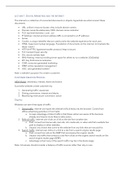Class notes
Digital Marketing Notes
- Course
- BUAD 200
- Institution
- Okanagan College ( )
Notes on digital marketing course, includes 12 lectures of notes, no specific textbook related to the notes. Topics include - Digital marketing and the internet - Marketing Research and Strategic Planning - Website Design & Development - Search Engines and Search Engine Marketing (SEM) ...
[Show more]



